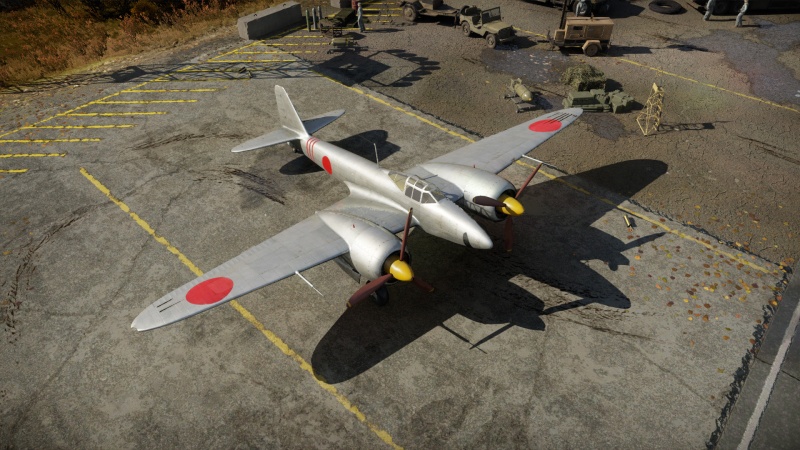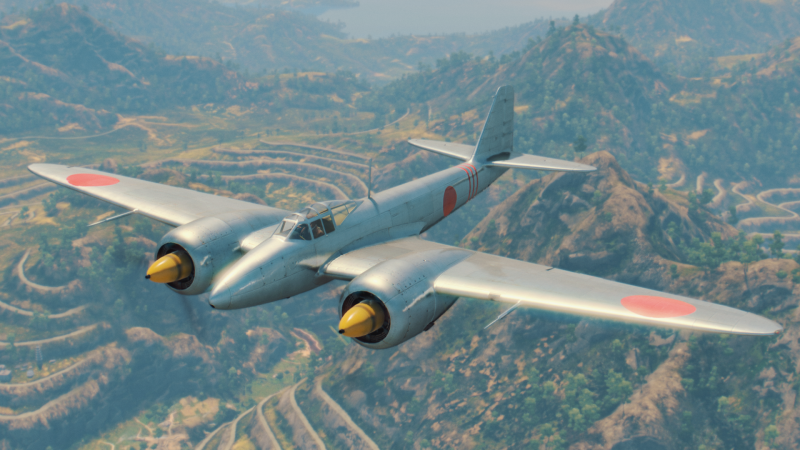Ki-96
Contents
Description
The Ki-96 was a twin-engined heavy fighter developed by Kawasaki as a private venture in 1942 after the success of their Ki-45 line. Like the Ki-45, it was a two-seat, twin-engined fighter with larger and more powerful Ha-112 radial engines to replace the Ki-45's Ha-104 engines. However, as the Japanese Army showed interest in the plane, they requested the plane as a single-seat interceptor, which resulted in two of the three prototypes being built with a smaller cockpit canopy, leaving the first with a two-seat-sized canopy for a single seat. The Ki-96 demonstrated excellent performance and handling, exceeding the estimates, but the Army changed its requirements back to a two-seat fighter, so the project was cancelled. The wings and tail unit of the Ki-96 were used for the Ki-102 two-seat fighter. The Ki-96 was armed with one 37 mm Ho-203 cannon and two 20 mm Ho-5 cannons mounted in its nose.
The Ki-96 was introduced in Update 1.35. Based on the latter 2 prototypes (most likely No.3), it has a smaller single-seat canopy, the Ki-96 is beyond what the Army initially requested. A twin-engine single-seat interceptor-fighter with great performance and handling, it will perform its role of interceptor to its full potential in tearing apart bombers from oblique angles, and outfighting enemy fighters in Boom-N-Zoom tactics. While it's a twin-engine aircraft, it's deceivingly agile and will be capable of dogfighting with single-engine aircraft. One last thing to note is while the armament packs a punch, ammunition is relatively scarce and should be used sparingly with trigger discipline.
General info
Flight performance
The Ki-96 is a generally smooth flyer and is characterized by its powerful armament, high speed, high climb rate, interceptor spawn and relatively good turn rate. All of these traits make for a solid interceptor that can shred through bombers like a hot katana through wet bamboo.
| Characteristics | Max Speed (km/h at 5,000 m) |
Max altitude (metres) |
Turn time (seconds) |
Rate of climb (metres/second) |
Take-off run (metres) | |||
|---|---|---|---|---|---|---|---|---|
| AB | RB | AB | RB | AB | RB | |||
| Stock | 568 | 553 | 25.3 | 25.7 | 14.5 | 14.5 | 380 | |
| Upgraded | 634 | 600 | 23.7 | 24.0 | 30.9 | 19.5 | ||
Details
| Features | ||||
|---|---|---|---|---|
| Combat flaps | Take-off flaps | Landing flaps | Air brakes | Arrestor gear |
| ✓ | ✓ | ✓ | X | X |
| Limits | ||||||
|---|---|---|---|---|---|---|
| Wings (km/h) | Gear (km/h) | Flaps (km/h) | Max Static G | |||
| Combat | Take-off | Landing | + | - | ||
| 762 | 437 | 408 | 260 | ~9 | ~8 | |
| Optimal velocities (km/h) | |||
|---|---|---|---|
| Ailerons | Rudder | Elevators | Radiator |
| < 360 | < 400 | < 400 | > 296 |
Survivability and armour
- 12 mm steel plating in the nose
- 16 mm steel plating behind the pilot
- Critical components located at the front of aircraft (fuel, pilot, engine, controls)
- Self-sealing fuel tanks in the wings
For a Japanese plane, the Ki-96 has a decent survivability, with armour plate protecting pilot from head-on and tailing attacks, thought one should never rely on it as the Ki-96 lacks a bulletproof glass and therefore is vulnerable to pilot sniping.
As with any other Japanese plane, the Ki-96 is volatile and will catch fire very easily. But, unlike any other Japanese fighters, the Ki-96 is able to survive a fire damage by turning off its engine and let its effective self-sealing fuel tanks do its job.
Modifications and economy
Armaments
Offensive armament
The Ki-96 is armed with:
- 1 x 37 mm Ho-203 cannon, nose-mounted (25 rpg)
- 2 x 20 mm Ho-5 cannons, chin-mounted (200 rpg = 400 total)
The Ki-96 is equipped with one 37 mm Ho-203 cannon and two 20 mm Ho-5 cannons mounted in its nose. The 37 mm gun has poor muzzle velocity and ammunition count, but a high rate of fire for its calibre and devastating damage output. While the 20 mm guns have a lesser damage output, they have a greater accuracy and ammunition count. Due to different gun characteristics, weapon selection should comes in handy, as you can choose between two set of guns for different situations. Use the 37 mm against slow or big targets like bombers to quickly finish them off, while the 20 mm are more useful against fast opponents and in a dogfight.
Usage in battles
One should fly the Ki-96 in its stated role: interceptor. When engaging bombers, be sure to approach from oblique angles and never tail one, as you have no bulletproof glass to protect your pilot from snipes. While bombers with good aim can snipe you, you can do the same to their plane in seconds when you land your devastating 37 mm cannon and 20 mm cannon shots. If all you encounter are fighters, it can make for a decent Boom-&-Zoom aircraft with its good speed, climb rate, and armament. It is good at turn-fighting as well and perhaps even one of its key strengths but should only be considered by experienced players because of its vulnerability, slow roll speed, and large wing span together with its low and heavy ammo. With these in mind, always try to engage fighters with an energy advantage, although be careful as the Ki-96's roll rate heavily stiffens above 643 km/h (400 mph), which makes it hard to control at high speeds.
Manual Engine Control
| MEC elements | ||||||
|---|---|---|---|---|---|---|
| Mixer | Pitch | Radiator | Supercharger | Turbocharger | ||
| Oil | Water | Type | ||||
| Not controllable | Controllable Auto control available |
Controllable Not auto controlled |
Controllable Not auto controlled |
Separate | Controllable 2 gears |
Not controllable |
Pros and cons
Pros:
- Powerful offensive armament mounted in the centre of the plane
- 37 mm gun has a good rate of fire for its calibre
- Fast, quicker than most Japanese planes at the same rank
- Turns well for a twin-engined fighter
- High climb rate
- Responsive elevator allows a quick snap turns
- Can survive multiple fires with proper engine control
- 360° cockpit view
Cons:
- Wings are littered with fuel tanks
- No bulletproof glass to protect the pilot
- Flight characteristics still has some limitations:
- Still outmanoeuvred and outsped by most single-engine fighters
- Poor energy retention
- Poor roll rate at all speed, especially above 640km/h
- Cockpit visibility is hampered by a large amount of structural bars
- 37 mm cannon has relatively low muzzle velocity
History
The Ki-96 was a twin-engined heavy fighter developed by Kawasaki Aeronautics in 1942 after the success of their Ki-45 line. Like the Ki-45, it was a two-seat, twin-engined fighter with larger and more powerful Ha-112 radial engines to replace the Ki-45's Ha-104 engines. It was intended to replace the "Toryu's" for the Imperial Japanese Army Air Service, but the Imperial Japanese Army Aviation Bureau insisted that it be converted to a single-seat fighter. The first prototype made retained the cockpit canopy intended for a two-seat fighter, and the next two prototypes were fitted with smaller canopies.
Despite showing performance exceeding estimates and having excellent handling, the Army's requirements had changed back to two-seat fighters, resulting in production and development on the Ki-96 being halted, with only three prototypes being made. However, the wings and tail unit would later go on to form the Ki-102 wings and tail.
Media
- Skins
See also
Links to the articles on the War Thunder Wiki that you think will be useful for the reader, for example:
- reference to the series of the aircraft;
- links to approximate analogues of other nations and research trees.
External links
| Kawasaki Aircraft Industries (川崎航空機工業株式会社) | |
|---|---|
| Biplane Fighters | Ki-10-I · Ki-10-I C · Ki-10-II · Ki-10-II C |
| Fighters | Ki-61-I ko · Ki-61-I otsu · Ki-61-I hei · Tada's Ki-61-I hei · Ki-61-I tei · Ki-61-II Otsu Kai |
| Ki-100 · Ki-100-II | |
| Interceptors | Ki-45 ko · Ki-45 otsu · Ki-45 hei · Ki-45 tei |
| Ki-96 | |
| Ki-102 otsu | |
| Ki-108 Kai | |
| Bombers | Ki-32 |
| Ki-48-II otsu | |
| Captured | ␗Ki-45 hei/tei · ␗Ki-61-I otsu · ▃Ki-61-Ib |
| See also | Kawasaki Shipyard Co. |
| Japan twin-engine fighters and strike aircraft | |
|---|---|
| Navy | |
| Land-based Fighter | |
| J1N | J1N1 |
| J5N | J5N1 |
| Army | |
| Ki-45 | Ki-45 ko · Ki-45 otsu · Ki-45 hei · Ki-45 tei |
| Ki-83 | Ki-83 |
| Ki-96 | Ki-96 |
| Ki-102 | Ki-102 otsu |
| Ki-108 | Ki-108 Kai |
| Ki-109 | Ki-109 |
| Japan premium aircraft | |
|---|---|
| Fighters | Hagiri's A5M4 · A7He1 · Ki-27 otsu Tachiarai |
| Ki-44-II otsu · ▅Bf 109 E-7 · ▅F4U-1A · Ki-100-II · Ki-44-I 34 | |
| ▅Fw 190 A-5 · A7M1 (NK9H) · Tada's Ki-61-I hei · ▅P-51C-11-NT | |
| J2M4 Kai · A6M5 Ko · A6M6c · J2M5 · Ki-87 · J6K1 | |
| Twin-engine fighters | Ki-96 |
| Jet fighters | F-86F-40 JASDF▅ · T-2 Early · F-4EJ ADTW |
| Strike aircraft | ▄AV-8S |
| Bombers | Ki-21-I hei · Ki-48-II otsu · H8K3 · B7A2 (Homare 23) · ▅B-17E |






